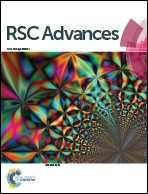Study on the room temperature synthesis of highly photoluminescent and temperature-sensitive CDs/PNIPAM hybrid hydrogels and their properties†
Abstract
In this present study, carbon dots (CDs) with strong fluorescence were introduced into poly(N-isopropylacrylamide) (PNIPAM) hydrogel (CDs/PNIPAM) in one pot at room temperature by atom transfer radical polymerization (ATRP). The method was simple, facile, but highly efficient and versatile. The obtained CDs/PNIPAM hybrid hydrogel was thought to combine through hydrogen bond assisted with spatial network embedding. Compared with the original CDs solution, the CDs/PNIPAM hybrid hydrogel showed temperature-sensitivity as well as strong fluorescence with a LCST of 33 °C. Around the LCST, a slight change of temperature affected the fluorescent intensity dramatically. For example, when the temperature increased from 32 °C to 33 °C, the fluorescence intensity of CDs/PNIPAM dropped sharply with a ratio of F32 to F33 as high as 3.5. Moreover, the fluorescence intensity recovered when the temperature fell. Through heating and cooling cycles, the fluorescence off–on phenomenon of the CDs/PNIPAM hybrid hydrogel was reversible and repeatable around the LCST region.


 Please wait while we load your content...
Please wait while we load your content...